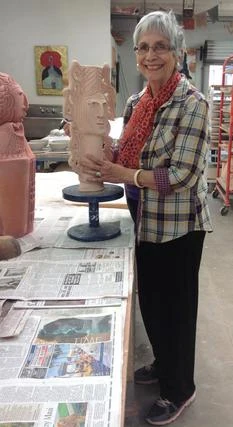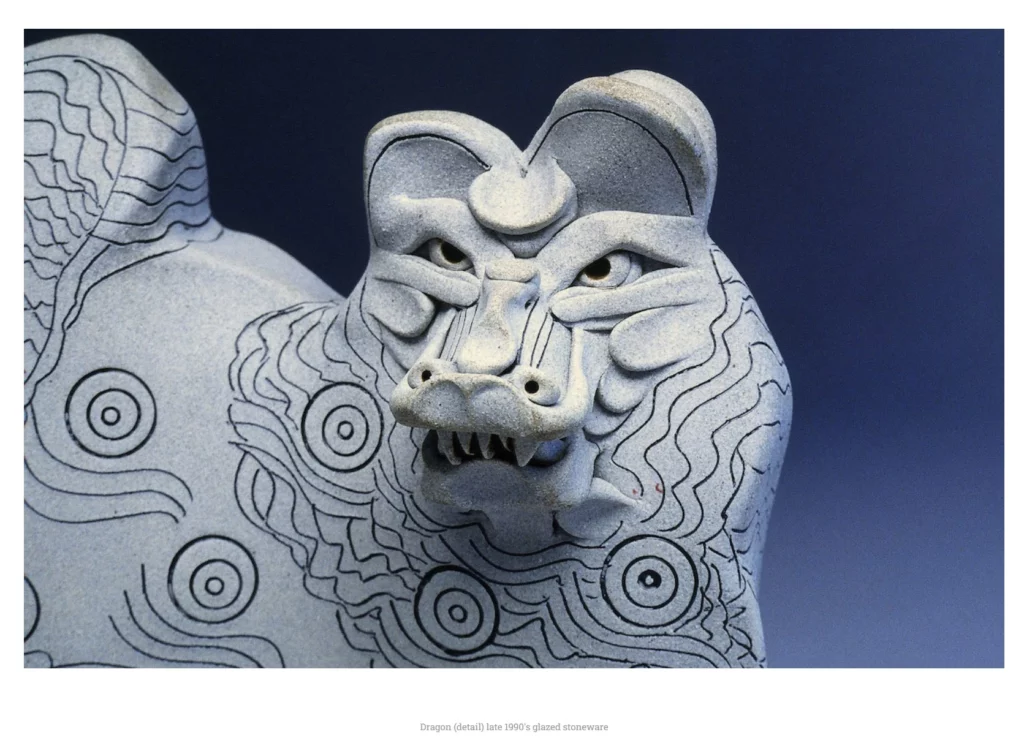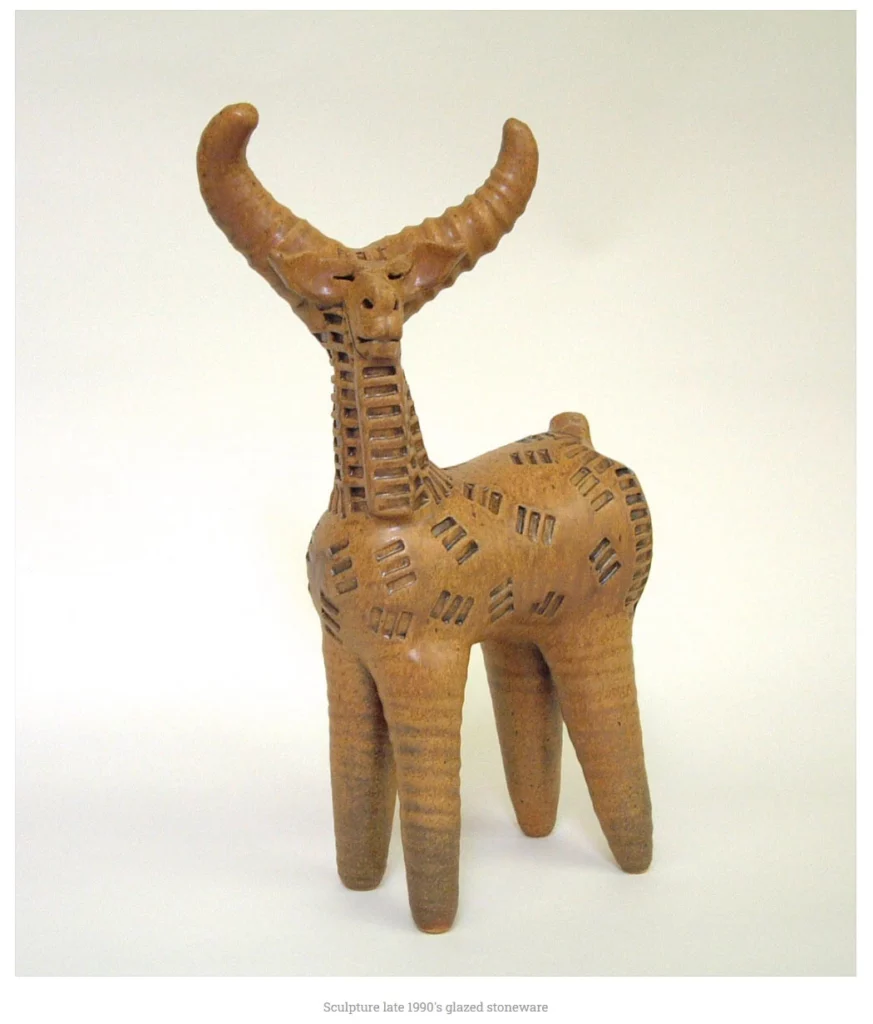Dora De Larios was an American ceramist and sculptor working in Los Angeles. Dora De Larios was known for her work’s clean lines, distinctive glazes, bright public murals, whimsical sculptures, as well as for her line of tableware created under her family-run company, Irving Place Studio. De Larios was best known for her distinctive mythological and pan-cultural styles.
Ceramic Artist Dora De Larios Facts
She was born in Los Angeles in 1933 and died on January 28, 2018. Dora De Larios was an American ceramist and sculptor who lived and worked in (De Larios grew up in) Los Angeles from imgrant parents Boyle Heights.
She was well known for her work’s clean lines and distinctive glazes, as well as for the dinnerware she designed for her family’s firm, Irving Place Studio, which she sold to the public.
De Larios was also a muralist who worked with tile, and she was well known for her distinctive style, which reflected mythological and pan-cultural themes in a male-dominated art world.
De Larios was raised in downtown Los Angeles near Silver Lake, where she was surrounded by Mexican and Nisei Japanese immigrants. She was inspired by her Mexican heritage. She was born in Los Angeles to Mexican immigrant parents and raised in downtown Los Angeles near Silver Lake.

What I Learned From Dora
What I learned from reading about Dora is a great way to draw inspiration and stimulate your creativity is to travel abroad and learn from other cultures. In the same way that Dora did. Her early visits to the Museo Nacional de Antropologa in Mexico City, as well as her exposure to a vast range of cultures, influenced her to produce artwork that incorporated elements of old American and Japanese ceramic traditions.

While at the University of Southern California, she worked with potters Otto and Vivika Heino, as well as Susan Peterson, to develop her skills. Some of her ceramic art lecturers introduced her to the work of radical ceramic artists like Peter Voulkos, whose abstract work inspired her to experiment with non-functional forms in clay. Her bachelor’s degree in ceramics with a minor in sculpture was awarded to her in 1957. Dora earned with a bachelor’s degree in ceramics and a minor in sculpture from the University of Southern California’s School of Fine Art in 1957, where she studied under noted ceramists Vivika and Otto Heino, as well as Susan Peterson.
Dora De Larios Style

De Larios seeks to achieve a balance between the animal and the spiritual, as well as the earthly and the holy. It is filled by mythological animals and goddesses who are both amusing and fierce in their appearance in her artistic universe.
As well as her more representational works, the contrast between opposing forces is visible in her abstract compositions, such as when spherical mandalas are surrounded by squares.
She transforms basic human difficulties into mystical and transforming works of art, which explains her international acclaim as an artist.
In today’s world, she is considered one of America’s most accomplished and innovative artist known with a long list of works that includes everything from place settings for the White House to a monumental cement wall sculpture in Nagoya, Japan.
Despite the fact that her art demonstrates clear influences from her Mexican origin (per-Columbian art), those who have been collecting her work for decades are just as likely to describe the figurative pieces as Asian, African, or Greek in nature.
With her University of Southern California study of world religions and ancient art, her travels across the world, and her upbringing in ethnically diverse Los Angeles, she has accumulated a unique collection of cultural influences that she incorporates into her artwork.
Dora De Larios Career

Following graduation, De Larios established an independent studio in Los Angeles, where she sold her work in a variety of places, including Gump’s Restaurant in San Francisco.
The artist established a particular style for her figural sculptures, which was influenced by ancient Japanese Haniwa techniques (Japanese art). The late artist and promoter Millard Sheets commissioned De Larios, along with other prominent ceramists such as Harrison McIntosh and Jerry Rothman, to develop titles for the Franciscan Ceramics division of Interpace in Los Angeles during the late 1960s and early 1970s.
After discovering bronze in the late 1960s, she began experimenting with it, making sculptures that were based on her own life experiences and observations. De Larios began experimenting with the mask form in the 1980s, spurred on by her involvement in the Mask Festival at the Craft and Folk Art Museum in New York City. She drew inspiration from religious and spiritual traditions from all around the world.
She has made it clear that she “I enjoy working on major projects” in public places: “I believe that I can reach a greater number of people, and I believe that part of what I do is a healing process for me.” To be honest, it’s always sounded appealing to me. It transports you to a location that has nothing to do with money or money-related transactions.
It restores and revitalizes the spirit. I enjoy having my paintings shown in public places because you never know who you might be able to assist.” De Larios did not have a gallery representation for the bulk of her career, instead opting to sell her work at regular studio sales throughout the country.
The death of Dora De Larios (De Larios passed away) in Culver City, California on January 28, 2018, occurred after a four-year struggle with ovarian cancer. She was 84 years old.
Museums And Exhibitions

He has had several solo and group exhibitions throughout Southern California, including the M.O.A. Gallery in West Hollywood in 1988 and 1990, the Marsha Rodell Gallery in Brentwood in 1982, National Museum, Bakersfield College in 1982, the Anhalt Gallery in Los Angeles (1967, 1969, and 1974), and the Zora Gallery in Los Angeles (1967, 1969, and 1974). De Larios was born in Los Angeles, California, and lives in Brentwood with his wife and son (1964).
Dora De Larios’s art was celebrated in 2009 with the exhibition Sueos / Yume: Fifty Years of the Art of Dora De Larios, which was organized by Elaine Levin and held at the Craft and Folk Art Museum.
In 2011, she was a significant figure in the exhibition Art Along the Hyphen: The Mexican-American Generation, which was held at the Autry Museum of the American West in California, United States. Her work was displayed at the American Museum of Ceramic Art in the exhibition ‘Common Ground: Ceramics in Southern California 1945–1975’, which opened the same year. Both exhibitions were organized as part of the Getty Foundation’s Pacific Standard Time: Art in Los Angeles initiative, which was funded by the Ford Foundation.
In 2017, two of De Larios’ sculptures were included in the Los Angeles County Museum of Art’s exhibition Found in Translation (Los Angeles Times): Design in California and Mexico, 1915-1985, which featured design from both California and Mexico. At the exhibition, it was made clear that the artist had strong connections with the traditions of old Mexican painting. Her Goddess totems (2009), which she had created in 2009, were added to the museum’s permanent collection the following year.
Dora De Larios: Other Worlds, a retrospective of her work held at the Main Museum in downtown Los Angeles in 2018, was a highlight of the year.
In 2017, and again in 2019, her work was included in shows at the Craig Krull Gallery in Santa Monica. De Larios’ work was on display in 2017 alongside the work of three other Mexican American artists, Gilbert Luján, Carlos Almarez, and Elsa Flores Almaraz, who were also part of the exhibition. The Studio is My Church, a 2019 exhibition that comprised paintings on paper from the artist’s final year of life, as well as ceramic sculptures, was organized by the artist.
De Larios’s Commissions
De Larios was the principal artist on the Grand Canyon Concourse fourth floor lobby mural in the Disney World Contemporary Resort in Orlando, which was completed in 1970–1971. He worked with the Franciscan Ceramics branch of Interpace and the Franciscan Ceramics division of Interpace. The porcelain tiles used in the mural, which was designed by Mary Blair and measured 18,000 square feet, were 12 inches square.
These highly diversified architectural works are highlighted by a 6’x30′ blue porcelain seascape created for the new Montage Resort & Spa in Laguna Beach, which is among the most remarkable of the lot. “Home to Quetzalcoatl,” a 36’x20′ monolith in cast cement, tile, and textured bronze in Pasadena Villa Parke, and three “Koi Goddesses” in the fountains of downtown Los Angeles’s Westin Bonaventure Hotel, are among the works on display.
A porcelain and gold leaf wall sculpture measuring 7 by 40 feet can be found in the foyer of the Anaheim Hilton.
Nissan Motors donated an 11’x20′ stainless steel and lit plexiglass artwork to the City of Carson, while a 10’x21′ brass gateway at the entrance to Chinatown’s Bamboo Plaza was donated by a private donor. Dora broadened her focus to work on other mediums like steel.
In 1977, De Larios was one of fourteen artists who were commissioned to create a tableware set for the Senate Wives Luncheon at the White House, which took place on the grounds of the White House. The Renwick Gallery of the Smithsonian Institution hosted a later exhibition of the series.
Among the other public commissions are:
- Laguna Beach’s Life Force was captured in 2003.
- At the Westin Bonaventure Hotel in Los Angeles, in 1997, there were Koi Goddesses.
- The Tree of Life in Culver City, California, was dedicated in 1997.
- In 1992, a tribute to Quetzalcoatl was held at the Villa-Park Community Center in Pasadena.
- The Elements performed in Los Angeles in 1989.
- The Hilton Anaheim hosted the 1984 production of The World According to Dora.
- Several public libraries in Compton, Lynwood, Norwood, and Rowland Heights have had exterior murals painted by the artist since 1973. (1978).
Contemporary Art – Contemporary art refers to art created in the second half of the twentieth century or the first decade of the twenty-first century. Contemporary artists live and work in a world that is impacted by the global community, culturally varied, and technologically advanced.
Screen print images from doradelarios.com website





